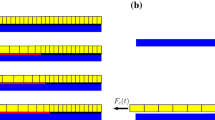Abstract
A cohesive crack model is applied to analyze the crack stability in elastic-softening materials. The shape of the global load-displacement response changes substantially by varying size-scale and keeping the geometrical shape of the structure unchanged. The softening branch becomes steeper and when the size-scale increases. A critical size-scale does exist for which the softening slope is infinite. In such a case, the load carrying capacity drastically decreases for relatively small displacement increments. Then, for larger size-scales, the softening slope becomes positive and a cusp catastrophe appears. It is proved that such a bifurcation point can be revealed by the simple LEFM condition.
Résumé
On utilise un modèle de fissure basé sur la cohésion pour analyser les conditions de fissuration stable dans des matériaux sensibles à l'adoucissement en condition élastique.
A formes géométriques égales, le profile de la courbe globale charge-déplacement se modifie considérablement avec une variation des dimensions d'une structure.
Lorsque l'échelle des dimensions est accrue, la portion correspondant à l'adoucissement devient de plus en plus raide, pour atteindre une pente infinite à une certaine échelle.
Il y correspond une décroissance brutale de la capacité de tenir la charge, pour de faibles accroissements de la déformation. Puis, pour des dimensions plus importantes, la pente de la coube d'adoucissement devient positive, et il apparaît des conditions de dégénérescence catastrophique.
On établit qu'un tel point de bifurcation peut être mis en évidence par la simple condition d'égalité de la mécanique linéaire élastique de la rupture.
Similar content being viewed by others
References
J.M.T. Thompson and P.A. Shorrock, Journal of Mechanics and Physics of Solids 23 (1975) 21–37.
J.M.T. Thompson and P.A. Shorrock, Nature 260 (1976) 598–599.
M. Potier-Ferry, International Journal of Engineering Science 23 (1985) 821–837.
R. Thom, Structural Stability and Morphogenesis, Benjamin, New York (1972).
A. Hillerborg, M. Modeer, and P.E. Petersson, Cement and Concrete Research 6 (1976) 773–782.
P.E. Petersson, Crack growth and development of fracture zones in plain concrete and similar materials, Report TVBM-1006, Division of Building Materials, Lund Institute of Technology (1981).
G. Colombo and E. Limido, in XI Convegno Nazionale dell' Associazone Italiana per l'Analisi delle Sollecitazioni, Torino (1983) 233–243.
A. Carpinteri, A. Di Tommaso, and M. Fanelli, Influence of material parameters and geometry on cohesive crack propagation, International Conference on Fracture Mechanics of Concrete, Lausanne, October 1–3, 1985.
ASTM, Standard Method of Test for Plane Strain Fracture Toughness of Metallic Materials, E 399–74.
A. Carpinteri, in Proceedings of the International Conference on Analytical and Experimental Fracture Mechanics, June 23–27, 1980, Roma, G.C. Sih and M. Mirabile (eds.), Sijthoff & Noordhoff (1981) 785–797.
A. Carpinteri, Engineering Fracture Mechanics 16 (1982) 467–481.
A. Carpinteri, C. Marega, and A. Savadori, Engineering Fracture Mechanics 21 (1985) 263–271.
A. Carpinteri, in Application of Fracture Mechanics to Cementitious Composites, NATO Advanced Research Workshop, September 4–7, 1984, Northwestern University, Martinus Nijhoff Publishers (1985) 287–316.
A. Carpinteri, in Structure and Crack Propagation in Brittle Matrix Composite Materials, Euromech Colloquium No. 204, November 12–15, 1985, Jablonna (Warsaw), Elsevier Applied Science Publishers (1986) 497–508.
K. Rokugo, S. Ohno, and W. Koyanagy, in International Conference on Fracture Mechanics of Concrete, Lausanne, October 1–3, 1985.
A. Carpinteri and G.C. Sih, Theoretical and Applied Fracture Mechanics 1 (1984) 145–159.
Z.P. Bazant and L. Cedolin, Journal of the Engineering Mechanics Division, ASCE 105 (1979) 297–315.
H. Tada, P. Paris, and G. Irwin, The Stress Analysis of Cracks Handbook, Del Research Corporation, St. Louis, Missouri (1963) 2.16–17.
Author information
Authors and Affiliations
Rights and permissions
About this article
Cite this article
Carpinteri, A. A catastrophe theory approach to fracture mechanics. Int J Fract 44, 57–69 (1990). https://doi.org/10.1007/BF00012552
Received:
Accepted:
Issue Date:
DOI: https://doi.org/10.1007/BF00012552




